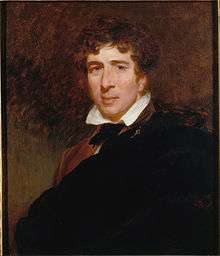Henry Perronet Briggs
Henry Perronet Briggs RA (1793 – 18 January 1844) was an English painter of portraits and historical scenes.[1][2]


Life
Briggs was born at Walworth, County Durham, the son of a post office official. His cousin was Amelia Opie (née Alderson), the wife of artist John Opie (whose portrait was later painted by Briggs). While still at school at Epping he sent two engravings to the Gentleman's Magazine and in 1811 entered as a student at the Royal Academy, London, where he began to exhibit in 1814. From that time onwards until his death he was a constant exhibitor at the annual exhibitions of the Academy, as well as the British Institution, his paintings being for the most part historical in subject. After his election as a Royal Academician (RA) in 1832 he devoted his attention almost exclusively to portraiture.
Briggs died, of tuberculosis in London on 18 January 1844. The lease to his home in Bruton Street, Berkeley Square was subsequently purchased by portrait painter Thomas Henry Illidge.
Jacob Bell, founder of the Pharmaceutical Society, was a cousin of Briggs, and took painting lessons from the artist as a child. Bell commissioned several art-works and it was his connections that enabled Briggs to paint the portraits of pharmacist John Bell (of John Bell & Co.),[3] and William Allen, the Society's first President. Briggs also designed the society's membership certificate.[4] Thomas Francis Dicksee was a notable pupil of Briggs.
Works
Two of Briggs' historical pictures, first exhibited at the Academy in 1826 and 1827, are now in Tate Britain, London – First Conference between the Spaniards and Peruvians, 1531,[5] and Juliet and her Nurse.[6] His large painting of George III presenting the Sword to Lord Howe on board the Queen Charlotte, 1794,[7] was initially purchased by the British Institution, presented to Greenwich Hospital, and is now in the National Maritime Museum. Among the more successful of the various Shakespearean scenes painted by him may be mentioned his Othello relating his adventures to Desdemona. Of his numerous portraits, the best perhaps was that of Lord Eldon. He also made the portrait of the Indian leader Raja Ram Mohan Roy.[8]
William Thackeray regarded Briggs as "out and out the best portrait-painter of the set";[1] though the Dictionary of National Biography entry (1886), by Warwick William Wroth, was more circumspect, commenting that "the pictures painted by Briggs, though not without merits of construction, cannot be said to belong to the highest class of art".
References
- "Henry Perronet Briggs". National Maritime Museum. London. Archived from the original on 8 June 2011.
- "Henry Perronet Briggs". drawpaintsculpt.com. Archived from the original on 6 October 2011.
- http://www.rpsgb.org.uk/informationresources/museum/exhibitions/jacobbell/man/family_history.html%5B%5D
- "Archived copy". Archived from the original on 24 August 2010. Retrieved 7 June 2010.CS1 maint: archived copy as title (link)
- "'The First Interview between the Spaniards and the Peruvians', Henry Perronet Briggs – Tate". Tate.
- "'Romeo and Juliet – Act II Scene 5 ("Juliet and her Nurse")', Henry Perronet Briggs". Tate.
- "National Maritime Museum". nmm.ac.uk. Archived from the original on 8 June 2011.
- Christopher Wright, Catherine May Gordon and Mary Peskett Smith.(2006) British and Irish Paintings in Public Collections: An Index of British and Irish oil paintings by artists born before 1870 in public and institutional collections in the United Kingdom and Ireland. Compilation. New Haven, Conn; London: Yale University Press. ISBN 0300117302, 9780300117301
- Attribution
![]()
External links
| Wikimedia Commons has media related to Henry Perronet Briggs. |
- 46 paintings by or after Henry Perronet Briggs at the Art UK site
- H P Briggs online (ArtCyclopedia)
- A Scene from 'The Adventures of Ferdinand Count Fathom' (1829 oil on panel - Christie's)